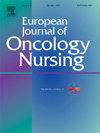Patient clusters based on demographics, clinical characteristics and cancer-related symptoms: A cross-sectional pilot study
IF 2.7
3区 医学
Q1 NURSING
引用次数: 0
Abstract
Purpose
This study aimed to identify and preliminary validate distinct clusters of patients with cancer based on demographics, clinical characteristics, and symptoms and to inform future research on sample size requirements for achieving sufficient power in clustering analyses.
Methods
This cross-sectional pilot study involved 114 patients with cancer from two hospitals in northern Italy. Data were collected on demographics, clinical characteristics, and 20 symptoms using the Edmonton Symptom Assessment System in October 2022. t-distributed stochastic neighbor embedding (t-SNE) was used to reduce the symptom data and demographics (e.g., age) into two components, which were then clustered using Ward's method. A Monte Carlo simulation was conducted based on the t-SNE components to estimate the sample size needed to achieve 80% power for different cluster solutions (k = 2, 3, 4).
Results
Two distinct clusters were identified: Cluster 1 (Higher Symptom Burden Cluster) and Cluster 2 (Lower Symptom Burden Cluster). Cluster 1 patients had a higher prevalence of depression, anxiety, and drowsiness. Monte Carlo simulations indicated that 50 patients per cluster were sufficient for k = 2 clusters to achieve 80% power, whereas 90 patients per cluster were needed for k = 3 clusters and 120 patients per cluster for k = 4 clusters.
Conclusion
This study identified distinct patient clusters and provided preliminary evidence on the sample size required for clustering analyses in cancer research. Understanding patient clusters enables nurses to provide tailored interventions, potentially improving symptom management and overall patient care.

基于人口统计学、临床特征和癌症相关症状的患者群:一项横断面试点研究
目的:本研究旨在根据人口统计学、临床特征和症状确定并初步验证不同的癌症患者聚类,并为未来的研究提供样本量要求,以获得足够的聚类分析能力。方法:这项横断面初步研究涉及来自意大利北部两家医院的114例癌症患者。2022年10月,使用埃德蒙顿症状评估系统收集了人口统计学、临床特征和20种症状的数据。使用t分布随机邻居嵌入(t-SNE)将症状数据和人口统计数据(如年龄)简化为两个组成部分,然后使用Ward方法对其进行聚类。基于t-SNE分量进行蒙特卡罗模拟,以估计不同聚类解决方案(k = 2,3,4)达到80%功率所需的样本量。结果:确定了两个不同的聚类:聚类1(高症状负担聚类)和聚类2(低症状负担聚类)。第1组患者有较高的抑郁、焦虑和嗜睡患病率。蒙特卡罗模拟表明,对于k = 2簇,每簇50名患者足以达到80%的功率,而对于k = 3簇,每簇需要90名患者,对于k = 4簇,每簇需要120名患者。结论:本研究确定了不同的患者群,并为癌症研究中聚类分析所需的样本量提供了初步证据。了解患者群使护士能够提供量身定制的干预措施,从而潜在地改善症状管理和整体患者护理。
本文章由计算机程序翻译,如有差异,请以英文原文为准。
求助全文
约1分钟内获得全文
求助全文
来源期刊
CiteScore
4.40
自引率
3.60%
发文量
109
审稿时长
57 days
期刊介绍:
The European Journal of Oncology Nursing is an international journal which publishes research of direct relevance to patient care, nurse education, management and policy development. EJON is proud to be the official journal of the European Oncology Nursing Society.
The journal publishes the following types of papers:
• Original research articles
• Review articles

 求助内容:
求助内容: 应助结果提醒方式:
应助结果提醒方式:


